Plant Science Research Weekly: April 3rd
Editorial: Redeploying plant defences
 With COVID19 ravaging across the globe, the medicinal value of plants and related research fields e.g., phytochemistry, ethnobotany, etc., is presently in focus. The drug development chain, though extremely promising, is not an immediate solution as it is a long, multistep process. Nature Plants highlights the potential for plant-based treatments to at least alleviate symptoms and severity of the viral infection. Secondary metabolites naturally produced by plants, though not a cure, have great potential to positively impact recovery rates. They are known in local contexts and available for use immediately. As examples, the Chinese government encouraged the use of traditional Chinese decoctions, which have years of clinical evidence to support their utility and side effects, as medications in its list of COVID19 management recommendations. Activities include antiviral properties (e.g., inhibition of viral entry or viral enzyme function) of Chinese skullcap extract (flavone baicalein), anti-influenza properties of some dandelion plant parts, and the antimalarial properties of quinine and Atrtemissia annua. Combinations of anti-inflammatory and antiviral herbs e.g., Lianhua Qingwen (11herbs), have been capsulated and were previously used successfully with the SARS virus. Investing in medicinal plant research and better understanding their taxonomy, ecology and conservation will be critical to management of future pandemics. (Summary by Sally Mallowa) Nature Plants 10.1038/s41477-020-0628-0
With COVID19 ravaging across the globe, the medicinal value of plants and related research fields e.g., phytochemistry, ethnobotany, etc., is presently in focus. The drug development chain, though extremely promising, is not an immediate solution as it is a long, multistep process. Nature Plants highlights the potential for plant-based treatments to at least alleviate symptoms and severity of the viral infection. Secondary metabolites naturally produced by plants, though not a cure, have great potential to positively impact recovery rates. They are known in local contexts and available for use immediately. As examples, the Chinese government encouraged the use of traditional Chinese decoctions, which have years of clinical evidence to support their utility and side effects, as medications in its list of COVID19 management recommendations. Activities include antiviral properties (e.g., inhibition of viral entry or viral enzyme function) of Chinese skullcap extract (flavone baicalein), anti-influenza properties of some dandelion plant parts, and the antimalarial properties of quinine and Atrtemissia annua. Combinations of anti-inflammatory and antiviral herbs e.g., Lianhua Qingwen (11herbs), have been capsulated and were previously used successfully with the SARS virus. Investing in medicinal plant research and better understanding their taxonomy, ecology and conservation will be critical to management of future pandemics. (Summary by Sally Mallowa) Nature Plants 10.1038/s41477-020-0628-0
Review. Twenty years of CBL-CIPKs: The knowns and the unknowns
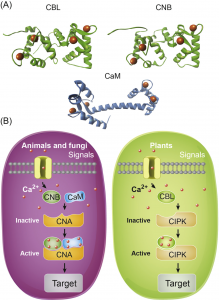 What are the chances that homologs of a vital animal protein could be found in plants, and how much structural and functional similarity would they share? These questions led to the discovery of Calcineurin B-like (CBL) and CBL-interacting protein kinase (CIPK) protein families in plants. In this review, Tang and co-workers discuss how knowledge of these proteins has grown over the years and aspects known and unknown about them. The current understanding suggests CBL-CIPKs to be a sensor-responder pair, where CBLs might ‘sense’ Calcium (Ca2+) and the signal response in effected through CIPKs. Surprisingly, CBLs were found to be homologous to one subunit of calcineurin and interact with a family of kinases, unlike calcineurin B, which interacts with a phosphatase. Now, two decades after their discovery, CBL-CIPKs have been characterized in a number of processes, especially in stress responses. The authors touch upon some hitherto unresolved aspects such as the elusive upstream activator of CIPKs, relevance of Ca2+ in CBL-CIPK-mediated responses, etc. Thus, this review article captures the shifting paradigm of CBL-CIPKs from their discovery, when, for example, CBLs were thought to interact exclusively with CIPKs, to now, when interaction of CBLs with other proteins has been conclusively demonstrated. (Summary by Pavithran Narayanan). Trends Plant Sci. 10.1016/j.tplants.2020.01.009
What are the chances that homologs of a vital animal protein could be found in plants, and how much structural and functional similarity would they share? These questions led to the discovery of Calcineurin B-like (CBL) and CBL-interacting protein kinase (CIPK) protein families in plants. In this review, Tang and co-workers discuss how knowledge of these proteins has grown over the years and aspects known and unknown about them. The current understanding suggests CBL-CIPKs to be a sensor-responder pair, where CBLs might ‘sense’ Calcium (Ca2+) and the signal response in effected through CIPKs. Surprisingly, CBLs were found to be homologous to one subunit of calcineurin and interact with a family of kinases, unlike calcineurin B, which interacts with a phosphatase. Now, two decades after their discovery, CBL-CIPKs have been characterized in a number of processes, especially in stress responses. The authors touch upon some hitherto unresolved aspects such as the elusive upstream activator of CIPKs, relevance of Ca2+ in CBL-CIPK-mediated responses, etc. Thus, this review article captures the shifting paradigm of CBL-CIPKs from their discovery, when, for example, CBLs were thought to interact exclusively with CIPKs, to now, when interaction of CBLs with other proteins has been conclusively demonstrated. (Summary by Pavithran Narayanan). Trends Plant Sci. 10.1016/j.tplants.2020.01.009
Gene balance predicts transcriptional responses immediately following ploidy change in Arabidopsis thaliana
 Throughout evolutionary time polyploidization events have occurred frequently, increasing the gene copy number (gene dosage) of multiple angiosperms. The gene balance hypothesis proposes that there is selection on gene copy number to maintain the stoichiometric balance between dosage-sensitive genes that are involved in multimeric complexes (e.g., transcription factors). However, if a whole-genome duplication occurs the balance between genes in dosage-sensitive groups is maintained. Here, Song et al. utilize a comprehensive set of accessions to investigate the gene dosage response immediately following ploidy changes in Arabidopsis. The set consists of two diploid accessions, their synthetic autopolyploids, a natural tetraploid and its haploid-induced synthetic diploid. RNA-seq was conducted for each accession to measure the transcriptome size, altered expression levels, and gene dosage responses immediately following the ploidy level alterations. The authors observed that genome doubling did not precisely induce transcriptome doubling, suggesting that expression levels and gene copy number are not strictly correlated. Furthermore, the gene dosage responses were highly variable for many loci. Nevertheless, the expression levels for genes in dosage-sensitive groups (GO terms, metabolic networks etc.) were less variable, with more coordinated gene dosage responses than less sensitive groups, thus supporting the gene balance hypothesis. Dosage responses are not significantly more coordinated within the natural-tetraploid versus the new synthetic polyploids, which implies that selection on dosage balance occurs immediately following a polyploidization event and is subsequently sustained. Future proteomic analyzes will validate whether dosage responses are reflected at the protein level. Moreover, the gene balance transcriptional responses observed may relate to transposable elements, a mechanism that requires future elucidation. (Summary by Caroline Dowling) Plant Cell 10.1105/tpc.19.00832
Throughout evolutionary time polyploidization events have occurred frequently, increasing the gene copy number (gene dosage) of multiple angiosperms. The gene balance hypothesis proposes that there is selection on gene copy number to maintain the stoichiometric balance between dosage-sensitive genes that are involved in multimeric complexes (e.g., transcription factors). However, if a whole-genome duplication occurs the balance between genes in dosage-sensitive groups is maintained. Here, Song et al. utilize a comprehensive set of accessions to investigate the gene dosage response immediately following ploidy changes in Arabidopsis. The set consists of two diploid accessions, their synthetic autopolyploids, a natural tetraploid and its haploid-induced synthetic diploid. RNA-seq was conducted for each accession to measure the transcriptome size, altered expression levels, and gene dosage responses immediately following the ploidy level alterations. The authors observed that genome doubling did not precisely induce transcriptome doubling, suggesting that expression levels and gene copy number are not strictly correlated. Furthermore, the gene dosage responses were highly variable for many loci. Nevertheless, the expression levels for genes in dosage-sensitive groups (GO terms, metabolic networks etc.) were less variable, with more coordinated gene dosage responses than less sensitive groups, thus supporting the gene balance hypothesis. Dosage responses are not significantly more coordinated within the natural-tetraploid versus the new synthetic polyploids, which implies that selection on dosage balance occurs immediately following a polyploidization event and is subsequently sustained. Future proteomic analyzes will validate whether dosage responses are reflected at the protein level. Moreover, the gene balance transcriptional responses observed may relate to transposable elements, a mechanism that requires future elucidation. (Summary by Caroline Dowling) Plant Cell 10.1105/tpc.19.00832
Water lily (Nymphaea thermarum) draft genome reveals variable genomic signatures of ancient cambium losses
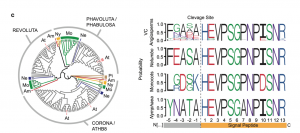 The vascular cambium, a meristematic tissue responsible for xylem and phloem production, is an ancestral trait in angiosperms, however, its loss has independently occurred in at least 5 flowering plant lineages. One of such is the Nymphaeales, which includes Nymphaea thermarum, an emergent model for early flowering plant evolution. Studies in several species have determined that the CLAVATA (CLE) signaling peptides, as well as redundantly-acting transcription factors of HD-ZIP III family, are necessary for secondary vascular differentiation. Although the molecular players required are known, the convergent loss of the vascular cambium poses the question of how pleiotropic and redundant genes evolve in the context of vascular cambium loss. In this study, Povilus et al. deciphered the N. thermarum genome, and by comparing it to genomes from cambium-bearing and cambium-less species, detected contraction of the HD-ZIP lll family in several cambium-less lineages. Specifically, loss of the REVOLUTA transcription factor, a known regulator of cambial initiation and xylem fiber differentiation, was observed in N. thermarum. In addition, the authors observed sequence divergence of essential residues in vascular-development associated CLE peptides from several cambium-less lineages. This study contributes to the understanding of how different genomic signatures between lineages may translate in homoplasious events, such as the loss of the vascular cambium, and provides a valuable resource for the study of early diverging angiosperms. (Summary by Jesus Leon) bioRxiv
The vascular cambium, a meristematic tissue responsible for xylem and phloem production, is an ancestral trait in angiosperms, however, its loss has independently occurred in at least 5 flowering plant lineages. One of such is the Nymphaeales, which includes Nymphaea thermarum, an emergent model for early flowering plant evolution. Studies in several species have determined that the CLAVATA (CLE) signaling peptides, as well as redundantly-acting transcription factors of HD-ZIP III family, are necessary for secondary vascular differentiation. Although the molecular players required are known, the convergent loss of the vascular cambium poses the question of how pleiotropic and redundant genes evolve in the context of vascular cambium loss. In this study, Povilus et al. deciphered the N. thermarum genome, and by comparing it to genomes from cambium-bearing and cambium-less species, detected contraction of the HD-ZIP lll family in several cambium-less lineages. Specifically, loss of the REVOLUTA transcription factor, a known regulator of cambial initiation and xylem fiber differentiation, was observed in N. thermarum. In addition, the authors observed sequence divergence of essential residues in vascular-development associated CLE peptides from several cambium-less lineages. This study contributes to the understanding of how different genomic signatures between lineages may translate in homoplasious events, such as the loss of the vascular cambium, and provides a valuable resource for the study of early diverging angiosperms. (Summary by Jesus Leon) bioRxiv
Integrated multi-omics framework of the plant response to jasmonic acid
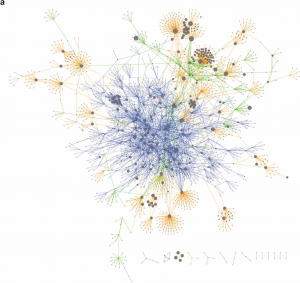 Jasmonic acid (JA) is involved in fertility, seed emergence and defense. JA perception and signal transduction are well understood, but there is limited understanding of the JA responsive genome regulatory program since only one or a small number of components are usually studied at once. Zander et al. report a multi-omics analysis of the JA regulatory network including the activities of the JA master transcription factor, MYC2, and its closest homologues. Genome-wide binding sites of MYC2 and MYC3 were identified through ChIP-seq analysis. Key findings include that almost all genes targeted by MYC3 were bound by MYC2, corroborating previous report that MYC2 and MYC3 function redundantly. Shared target genes were enriched for JA- and other hormone-related gene ontology and for DNA binding and transcriptional regulatory domains. Furthermore, these two transcription factors were also shown to directly target several hundreds of other transcription factors leading to a large gene regulatory network conferring both amplification and crosstalk. Genome-wide profiling through ChIP-seq analysis revealed MYC2’s contribution to JA-induced changes in chromatin architecture, and MYC2’s influence on the proteome and phosphoproteome was also demonstrated. Finally, a network model that predicted new components of JA signaling was generated and validated by genetic analysis. (Summary by Tolu Olukayode) Nature Plants 10.1038/s41477-020-0605-7
Jasmonic acid (JA) is involved in fertility, seed emergence and defense. JA perception and signal transduction are well understood, but there is limited understanding of the JA responsive genome regulatory program since only one or a small number of components are usually studied at once. Zander et al. report a multi-omics analysis of the JA regulatory network including the activities of the JA master transcription factor, MYC2, and its closest homologues. Genome-wide binding sites of MYC2 and MYC3 were identified through ChIP-seq analysis. Key findings include that almost all genes targeted by MYC3 were bound by MYC2, corroborating previous report that MYC2 and MYC3 function redundantly. Shared target genes were enriched for JA- and other hormone-related gene ontology and for DNA binding and transcriptional regulatory domains. Furthermore, these two transcription factors were also shown to directly target several hundreds of other transcription factors leading to a large gene regulatory network conferring both amplification and crosstalk. Genome-wide profiling through ChIP-seq analysis revealed MYC2’s contribution to JA-induced changes in chromatin architecture, and MYC2’s influence on the proteome and phosphoproteome was also demonstrated. Finally, a network model that predicted new components of JA signaling was generated and validated by genetic analysis. (Summary by Tolu Olukayode) Nature Plants 10.1038/s41477-020-0605-7
Unlocking interspecies grafting
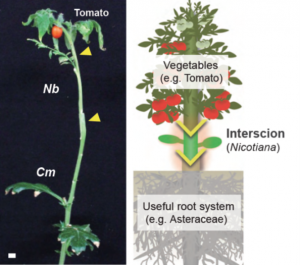 Plant grafting is an agricultural technique that joins plant tissues (e.g., the shoot and root) to confer beneficial traits from one plant to another. Although interfamily grafting is difficult in general, Notaguchi et al. found that Nicotiana benthamiana (Nb) has a strong potential to graft with phylogenetically distant plant species. Transcriptome analysis revealed that genes encoding cell wall-modification enzymes were induced at the junction of interspecies grafting involving Nb. Among such genes was NbGH9B3 encoding β-1,4-glucanase, which might degrade cellulose in the cell wall to promote cell-cell adhesion. Mutant analysis revealed that NbGH9B3 contributes to the grafting between Nb and Arabidopsis thaliana (At), and, when ectopically expressed, NbGH9B3 promoted grafting between At tissues (intrafamily grafting). Induction of GH9B3 homologs at the graft interface was a common trait in various plant species in the compatible intrafamily grafts, but Nb had a unique capability to induce this gene during interfamily grafting. This prompted the authors to use Nb as a grafting intermediate and, by doing so, they successfully grafted tomato to At or Chrysanthemum morifolium. This study deepens our mechanistic understanding of grafting and demonstrated Nb as a potent facilitator of interfamily grafting of plants with agricultural values. (Summary by Tatsuya Nobori) bioRxiv 10.1101/2020.03.26.010744
Plant grafting is an agricultural technique that joins plant tissues (e.g., the shoot and root) to confer beneficial traits from one plant to another. Although interfamily grafting is difficult in general, Notaguchi et al. found that Nicotiana benthamiana (Nb) has a strong potential to graft with phylogenetically distant plant species. Transcriptome analysis revealed that genes encoding cell wall-modification enzymes were induced at the junction of interspecies grafting involving Nb. Among such genes was NbGH9B3 encoding β-1,4-glucanase, which might degrade cellulose in the cell wall to promote cell-cell adhesion. Mutant analysis revealed that NbGH9B3 contributes to the grafting between Nb and Arabidopsis thaliana (At), and, when ectopically expressed, NbGH9B3 promoted grafting between At tissues (intrafamily grafting). Induction of GH9B3 homologs at the graft interface was a common trait in various plant species in the compatible intrafamily grafts, but Nb had a unique capability to induce this gene during interfamily grafting. This prompted the authors to use Nb as a grafting intermediate and, by doing so, they successfully grafted tomato to At or Chrysanthemum morifolium. This study deepens our mechanistic understanding of grafting and demonstrated Nb as a potent facilitator of interfamily grafting of plants with agricultural values. (Summary by Tatsuya Nobori) bioRxiv 10.1101/2020.03.26.010744
Understanding Evening Complex activity
 Processes like photosynthesis and growth follow a well-defined rhythm driven by a 24-h internal clock that is controlled by three principal interacting transcription–translation feedback loops: the morning, central, and evening loops. The Evening Complex (EC), which is active at the end of the day, participates in the transcriptional repression of the morning loop genes. In a recent study, Silva and colleagues provided an in vitro model for Evening Complex (EC) activity, including binding affinity, specificity, and complex formation. EC is composed of LUX ARRHYTHMO (LUX), EARLY FLOWERING 3 (ELF3), and ELF4. Since LUX is the only protein in the complex with a DNA-binding capacity, the authors used protein binding microarrays to determine its affinity and specificity. Structural analysis of the LUX-DNA complex allowed the identification of critical residues involved in DNA-binding. With this information, authors generated a version of LUX with reduced binding affinity, LUXR146A, which has an in vivo effect. To determine the role of ELF3 and ELF4 in the EC formation and function, authors reconstituted different sub-complexes in vitro and analyzed their DNA-binding features. LUX-ELF3 has low DNA binding capacity, and the addition of EFL4 results in an increase in the high-affinity DNA-binding. The DNA-binding capacity of LUX alone is not temperature-dependent, but with increased temperature the binding of the whole complex is attenuated. In this scenario, ELF4 confirms its prominent role in the EC binding stabilization, since high concentrations of ELF4 (~20-fold excess) can restore DNA-binding at high temperatures. (Summary by Humberto Herrera-Ubaldo) Proc. Natl. Acad. Sci. USA
Processes like photosynthesis and growth follow a well-defined rhythm driven by a 24-h internal clock that is controlled by three principal interacting transcription–translation feedback loops: the morning, central, and evening loops. The Evening Complex (EC), which is active at the end of the day, participates in the transcriptional repression of the morning loop genes. In a recent study, Silva and colleagues provided an in vitro model for Evening Complex (EC) activity, including binding affinity, specificity, and complex formation. EC is composed of LUX ARRHYTHMO (LUX), EARLY FLOWERING 3 (ELF3), and ELF4. Since LUX is the only protein in the complex with a DNA-binding capacity, the authors used protein binding microarrays to determine its affinity and specificity. Structural analysis of the LUX-DNA complex allowed the identification of critical residues involved in DNA-binding. With this information, authors generated a version of LUX with reduced binding affinity, LUXR146A, which has an in vivo effect. To determine the role of ELF3 and ELF4 in the EC formation and function, authors reconstituted different sub-complexes in vitro and analyzed their DNA-binding features. LUX-ELF3 has low DNA binding capacity, and the addition of EFL4 results in an increase in the high-affinity DNA-binding. The DNA-binding capacity of LUX alone is not temperature-dependent, but with increased temperature the binding of the whole complex is attenuated. In this scenario, ELF4 confirms its prominent role in the EC binding stabilization, since high concentrations of ELF4 (~20-fold excess) can restore DNA-binding at high temperatures. (Summary by Humberto Herrera-Ubaldo) Proc. Natl. Acad. Sci. USA
GIGANTEA shapes the photoperiodic rhythms of termomorphogenic growth in Arabidopsis
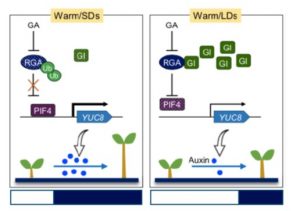 Plants evolved molecular mechanisms to integrate seasonal changes with developmental programs. For example, warmer temperatures and increasing day-length mark the transition from winter to spring, and trigger flowering. Now, the synchronisation of ambient temperature and photoperiod is perturbed by global warming, which causes growth alteration in different plant species. Nevertheless, plants are able to modify their architecture to dissipate heat through a process called thermomorphogenesis. One of these responses relies on hypocotyl elongation, and is mediated by the thermo-sensory function of phytochromes. The activation of PHYTOCHROME INTERACTING FACTOR 4 (PIF4) at warm temperatures promotes the accumulation of auxin, causing hypocotyl overgrowth. This thermo-induced response is also coordinated by day-length through regulatory mechanisms still unresolved. In this paper, Park et al. provide a link between photoperiod sensing and thermomorphogenesis. They investigated thermo-induced responses in Arabidopsis using loss of function mutations in GIGANTEA (GI), a clock component previously involved in photoperiodic flowering and chaperone activity. Further protein-protein interaction studies indicated that GI accumulation at warm temperatures under Long Days causes the stabilisation of PIF4 suppressors DELLA. By contrast, reduced GI protein levels and increased degradation of DELLAs under Short Days associate with the release of PIF4, which triggers hypocotyl elongation mediated by increased auxin biosynthesis. (Summary by Michela Osnato) Mol. Plant 10.1016/j.molp.2020.01.003
Plants evolved molecular mechanisms to integrate seasonal changes with developmental programs. For example, warmer temperatures and increasing day-length mark the transition from winter to spring, and trigger flowering. Now, the synchronisation of ambient temperature and photoperiod is perturbed by global warming, which causes growth alteration in different plant species. Nevertheless, plants are able to modify their architecture to dissipate heat through a process called thermomorphogenesis. One of these responses relies on hypocotyl elongation, and is mediated by the thermo-sensory function of phytochromes. The activation of PHYTOCHROME INTERACTING FACTOR 4 (PIF4) at warm temperatures promotes the accumulation of auxin, causing hypocotyl overgrowth. This thermo-induced response is also coordinated by day-length through regulatory mechanisms still unresolved. In this paper, Park et al. provide a link between photoperiod sensing and thermomorphogenesis. They investigated thermo-induced responses in Arabidopsis using loss of function mutations in GIGANTEA (GI), a clock component previously involved in photoperiodic flowering and chaperone activity. Further protein-protein interaction studies indicated that GI accumulation at warm temperatures under Long Days causes the stabilisation of PIF4 suppressors DELLA. By contrast, reduced GI protein levels and increased degradation of DELLAs under Short Days associate with the release of PIF4, which triggers hypocotyl elongation mediated by increased auxin biosynthesis. (Summary by Michela Osnato) Mol. Plant 10.1016/j.molp.2020.01.003
The circadian clock influences the long-term water use efficiency of Arabidopsis
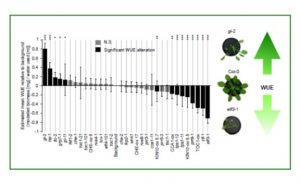 The volume of water required for a given crop yield is largely influenced by the plant’s Water Use Efficiency (WUE). Considering that the majority of the water taken up by plants is lost through transpiration, WUE can be improved by modulating stomatal opening. Besides light and temperature, stomatal function is also regulated by circadian rhythms generated by the circadian oscillator. In order to investigate the contribution of the circadian clock on WUE in Arabidopsis, Simon et al. surveyed 32 loss- and gain-of-function mutants in genes associated with the circadian oscillator, and found significant WUE alterations in almost half of the genotypes (compared to wild types). These changes appeared to be associated with altered transpiration and altered biomass accumulation in lines with mis-regulated circadian clock genes. Across genotypes, a correlation exists between WUE and rosette architecture, which ultimately determine gas exchange. Nevertheless, the control of WUE mediated by the circadian oscillator seems to be more complex, and cannot be explained only by alteration of the rosette surface area. Therefore, further investigation is needed to develop crops with increased WUE. (Summary by Michela Osnato) Plant Physiol. 10.1104/pp.20.00030
The volume of water required for a given crop yield is largely influenced by the plant’s Water Use Efficiency (WUE). Considering that the majority of the water taken up by plants is lost through transpiration, WUE can be improved by modulating stomatal opening. Besides light and temperature, stomatal function is also regulated by circadian rhythms generated by the circadian oscillator. In order to investigate the contribution of the circadian clock on WUE in Arabidopsis, Simon et al. surveyed 32 loss- and gain-of-function mutants in genes associated with the circadian oscillator, and found significant WUE alterations in almost half of the genotypes (compared to wild types). These changes appeared to be associated with altered transpiration and altered biomass accumulation in lines with mis-regulated circadian clock genes. Across genotypes, a correlation exists between WUE and rosette architecture, which ultimately determine gas exchange. Nevertheless, the control of WUE mediated by the circadian oscillator seems to be more complex, and cannot be explained only by alteration of the rosette surface area. Therefore, further investigation is needed to develop crops with increased WUE. (Summary by Michela Osnato) Plant Physiol. 10.1104/pp.20.00030
A plant-specific protein, COST1, mediates autophagy to promote drought tolerance
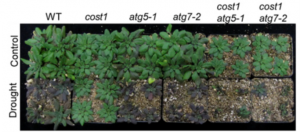 Much remains to be learned about the sensing and signaling mechanisms controlling growth in response to drought. To dissect how plants control drought via autophagy, Bao et al. found a plant-specific protein, COST1 (CONSTITUTIVELY STRESSED 1) containing a DUF641 (domain of unknown function 641) domain, that is required for normal growth but negatively regulates drought response. Under normal growth conditions, the cost1 mutant grows much smaller than the wild type but with more drought resistance. The COST1 transcript does not change during stress treatments but the protein stability is affected by 26S-proteosome degradation pathway and autophagy. The subcellular localization of COST1 is observed as punctate-like structure in the cytoplasm upon drought treatment. COST1 also colocalizes and interacts with the autophagosome marker ATG8 (autophagy-related). The double mutants cost1 atg has similar drought-sensitive phenotype as the atg mutant, revealing the genetic interaction of ATG as a downstream component of COST1. This finding shows a plant-specific protein, COST1, regulates the balance between growth and drought resistance through autophagy. As COST1 is conserved throughout the plant kingdom, that will be interesting to study this gene as a potential drought tolerance protein in agricultural species. (Summary by Min May Wong) PNAS 10.1073/pnas.1918539117
Much remains to be learned about the sensing and signaling mechanisms controlling growth in response to drought. To dissect how plants control drought via autophagy, Bao et al. found a plant-specific protein, COST1 (CONSTITUTIVELY STRESSED 1) containing a DUF641 (domain of unknown function 641) domain, that is required for normal growth but negatively regulates drought response. Under normal growth conditions, the cost1 mutant grows much smaller than the wild type but with more drought resistance. The COST1 transcript does not change during stress treatments but the protein stability is affected by 26S-proteosome degradation pathway and autophagy. The subcellular localization of COST1 is observed as punctate-like structure in the cytoplasm upon drought treatment. COST1 also colocalizes and interacts with the autophagosome marker ATG8 (autophagy-related). The double mutants cost1 atg has similar drought-sensitive phenotype as the atg mutant, revealing the genetic interaction of ATG as a downstream component of COST1. This finding shows a plant-specific protein, COST1, regulates the balance between growth and drought resistance through autophagy. As COST1 is conserved throughout the plant kingdom, that will be interesting to study this gene as a potential drought tolerance protein in agricultural species. (Summary by Min May Wong) PNAS 10.1073/pnas.1918539117
FERONIA controls pectin- and nitric oxide-mediated male–female interaction
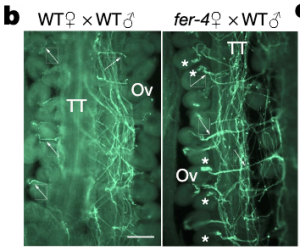 In flowering plants, fertilization occurs when a pollen tube, growing down the transmitting tissue, arrives at the ovule, ruptures, and releases its content of sperm cells. The pollen tube is guided towards the ovule by LUREs, small cysteine-rich secreted peptides. Timely rupturing and sperm release depend on the ovule-expressed receptor kinase FERONIA. In this paper, Duan et al. investigate molecular events taking place at the ovule to prevent additional, late-arriving pollen tubes from entering the ovule, so called polyspermy. They find that two FERONIA-dependent events: pectin de-esterification and nitric oxide production are involved in blocking polyspermy. They further show that nitric oxide can modify LURE1 on specific cysteine residues, and that the nitrosated peptide no longer functions as a chemoattractant in an in vitro pollen tube growth assay. While interesting questions remain as to the role(s) of FERONIA in the regulatory hierarchy, this paper suggests a molecular mechanism that helps ensure flowering plant fertilization fidelity. (Summary by Frej Tulin) Nature 10.1038/s41586-020-2106-2
In flowering plants, fertilization occurs when a pollen tube, growing down the transmitting tissue, arrives at the ovule, ruptures, and releases its content of sperm cells. The pollen tube is guided towards the ovule by LUREs, small cysteine-rich secreted peptides. Timely rupturing and sperm release depend on the ovule-expressed receptor kinase FERONIA. In this paper, Duan et al. investigate molecular events taking place at the ovule to prevent additional, late-arriving pollen tubes from entering the ovule, so called polyspermy. They find that two FERONIA-dependent events: pectin de-esterification and nitric oxide production are involved in blocking polyspermy. They further show that nitric oxide can modify LURE1 on specific cysteine residues, and that the nitrosated peptide no longer functions as a chemoattractant in an in vitro pollen tube growth assay. While interesting questions remain as to the role(s) of FERONIA in the regulatory hierarchy, this paper suggests a molecular mechanism that helps ensure flowering plant fertilization fidelity. (Summary by Frej Tulin) Nature 10.1038/s41586-020-2106-2
Ecological strategies begin at germination: Traits, plasticity, and survival in the first four days of plant life ($)
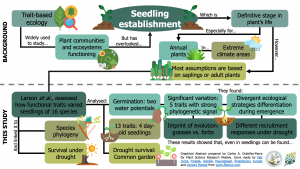 Seedling establishment is seldom addressed in trait-based ecology. Advocating for the importance of this stage of a plants’ life, Larson et al. assessed how functional traits varied in newly emerged seedlings and how this was related to their phylogeny and survival under drought. The authors germinated seeds of sixteen species of grasses and forbs under two water potential conditions. After three seeds of each replicate germinated, three individuals were randomly selected and grown for four additional days. The authors measured traits related to seeds, seedling growth, resource allocation, and tissue construction and recorded seedlings survival under drought by transplanting seedlings into pots watered only at the beginning of the experiment. The authors found significant trait variation among species, and a strong tendency of related species to share similar attributes in five of them (mostly regarding root investment). They show this variation was associated to both species plastic responses (i.e., attribute variation in response to drought within a species) and to different ecological strategies (e.g., slow vs. fast growing), which had a different effect on their survival in drought conditions. (Summary by Carlos A. Ordóñez-Parra) Funct. Ecol. 10.1111/1365-2435.13543
Seedling establishment is seldom addressed in trait-based ecology. Advocating for the importance of this stage of a plants’ life, Larson et al. assessed how functional traits varied in newly emerged seedlings and how this was related to their phylogeny and survival under drought. The authors germinated seeds of sixteen species of grasses and forbs under two water potential conditions. After three seeds of each replicate germinated, three individuals were randomly selected and grown for four additional days. The authors measured traits related to seeds, seedling growth, resource allocation, and tissue construction and recorded seedlings survival under drought by transplanting seedlings into pots watered only at the beginning of the experiment. The authors found significant trait variation among species, and a strong tendency of related species to share similar attributes in five of them (mostly regarding root investment). They show this variation was associated to both species plastic responses (i.e., attribute variation in response to drought within a species) and to different ecological strategies (e.g., slow vs. fast growing), which had a different effect on their survival in drought conditions. (Summary by Carlos A. Ordóñez-Parra) Funct. Ecol. 10.1111/1365-2435.13543



